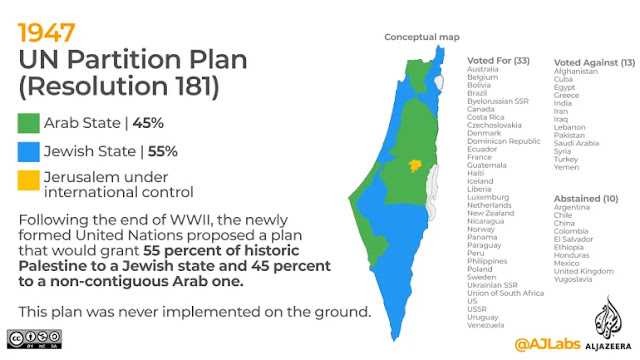Here, using maps and charts, is a brief history of the conflict as Gaza struggles to recover from Israel's devastating bombardments.
The bloodiest war that Israel has fought against the besieged Palestinian enclave to date has resulted in the deaths of nearly 15,000 people, including 10,000 women and children, in Gaza over the course of more than 50 days.
As the humanitarian truce, which lasted for four days, comes to an end on November 28, Israel has rejected requests for a ceasefire. The continuation of the truce is in doubt.
Protests around the world have been sparked by Gaza's devastation and rising death toll, elevating the decades-old issue to the forefront of global politics.
The Balfour Declaration In the Balfour Declaration,
Britain pledged to establish a national home for the Jewish people in Palestine during World War I. This began a nearly century-long dispute between Israel and Palestine. At the end of October 1917, British troops conquered the Ottoman Empire's territory.
Jewish immigration to Palestine
Jewish people began migrating to Palestine in large numbers, which was sped up by Jews fleeing Nazism in Europe. The percentage of Jews living in Palestine increased from 6% in 1918 to 33% in 1947. The shift in the population alarmed Palestinians, which led to an increase in tensions and the Palestinian uprising that took place from 1936 to 1939.
Zionist organizations continued to advocate for a Jewish homeland in Palestine in the interim. Palestinians were forced to flee when armed Zionist militias began attacking them. In the latter part of the 19th century, Zionism emerged as a political ideology and called for the establishment of a Jewish homeland.
The UN Partition Plan
The conflict in Palestine was brought to the attention of the newly established United Nations. Resolution 181, which called for the division of Palestine into Arab and Jewish states and the transfer of approximately 55% of the land to Jews, was approved by the United Nations in 1947. Jerusalem was declared a separate internationalized territory while Arabs were given 45% of the land.
At the moment, the city is split between East Jerusalem, which is mostly Palestinian, and West Jerusalem, which is mostly Jewish. After the Six-Day War in 1967, Israel took East Jerusalem and the West Bank, a move that the international community didn't acknowledge.
Christians, Muslims, and Jews all hold religious significance for the Old City in occupied East Jerusalem. The Al-Aqsa Mosque compound, also known as al-Haram al-Sharif to Muslims and Temple Mount to Jews, can be found there.
The United Nations designated it a World Heritage Site in 1981.
The Nakba
Prior to the founding of Israel in 1948, Zionist militias ethnically expelled over 750,000 Palestinians from their homes. The Nakba, or catastrophe, was the name given to this mass exodus.
The Six-Day War in 1967 resulted in the displacement of an additional 300,000 Palestinians.
Even though East Jerusalem was annexed by Israel in 1980, the international community still views it as occupied territory. Palestinians need East Jerusalem as the capital of their future state.
The Oslo Accords
were signed in 1993 by Israeli Prime Minister Yitzhak Rabin and Palestinian leader Yasser Arafat with the goal of achieving peace within five years. The two sides recognized each other for the first time.
The occupied West Bank was divided into three parts by a second agreement in 1995: Area A, B, and C. The Palestinian Authority, which was established as a result of the Oslo Accords, was only given limited authority over 18 percent of the land because Israel effectively retained control of the West Bank.
Checkpoints and Israeli settlements, on the other hand, caused the Oslo Accords to slowly fall apart as rapidly expanding Israeli settlements, Jewish communities built on Palestinian land in the West Bank.
The number of people living in settlements in the West Bank and East Jerusalem increased from around 250,000 in 1993 to as many as 700,000 in September of this year. The occupied West Bank and East Jerusalem are home to approximately three million Palestinians. Palestinian communities have been dispersed and have been restricted in their mobility as a result of the construction of Israeli settlements and a separation wall in occupied territory. The West Bank is home to 140 checkpoints and approximately 700 road obstacles. During their daily commute, approximately 70,000 Palestinians with Israeli work permits cross these checkpoints.
Under international law, settlements are prohibited. As part of the so-called "two-state solution," the United Nations has condemned settlements, describing them as a significant obstacle to the establishment of a viable Palestinian state.
Israel imposed a blockade on Gaza
in 2007 following the rise to power of Hamas. To this day, the siege continues. The West Bank and East Jerusalem, which Palestinians want to be a part of their future state, are also under Israeli occupation. Following a surprise Hamas attack inside Israel, Israel imposed a total blockade on the Gaza Strip on October 9, cutting off its supplies of electricity, food, water, fuel, and fuel. In that attack, at least 1,200 people were killed.
Israel and Palestine
as they are now This is how Israel and Palestine currently appear.
About 5 million Palestinians currently reside in East Jerusalem, the West Bank, and Gaza, and 1.6 million Palestinians are Israeli citizens. About half of their total population consists of this. The remaining half resides in other nations,
including Arab nations. Today, there are approximately 14.7 million Jews worldwide, with Israel and the United States accounting for 84%. The rest live in different nations including France, Canada, Argentina and Russia.











Post a Comment